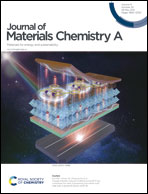Advanced electrode materials for nonaqueous calcium rechargeable batteries
Abstract
Calcium (Ca)-based rechargeable batteries (CRBs) have been considered one of the most promising post-lithium ion battery technologies because of the natural abundance of Ca, high volumetric capacity compared to monovalent metal batteries, and the low reduction potential of Ca2+/Ca. Recently, a breakthrough of Ca reversible plating and stripping at the Ca metal anode in carbonate electrolytes has induced the study of Ca rechargeable batteries. This critical review presents the state-of-the-art progress made in exploring potential electrode materials including Ca metal anodes, alternative graphite and alloy-type anodes, and cathode materials undergoing interaction or conversion reactions. Suitable electrolytes are also required to ensure the compatibility of each cell component, which is essential toward high-performance Ca full batteries. The performance assessment and mechanism analysis are further discussed to evaluate the current progress and existing challenges regarding the performance promise and insufficient understanding of the Ca battery technology. To conclude, this review provides a comprehensive understanding of the underlying mechanisms and challenges that need to be addressed to promote the commercialization of CRBs.



 Please wait while we load your content...
Please wait while we load your content...